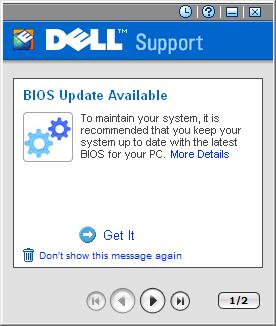Day 1 with a new Dell and Vista

Last Monday, the UPS guy showed up with a new Dell C521. It’s destined to take over as my Vista Media Center machine, but right now it has a more important role to play: It’s the first machine I’ve bought with a fresh OEM installation of Windows Vista. I’ve done clean installs and retail upgrades and Express Upgrades, and I’ve played with some OEM machines from HP and Acer, but this is the first factory-equipped Vista PC I’ve set up for long-term use.
 I’ve read plenty of complaints about Vista performance and compatibility, so I’m anxious to see how this one stacks up. My goal, over the next week or two, is to document the process of using this machine and keep a careful eye on its performance and reliability. How does it run in its stock configuration? What happens as I add hardware and software and drivers and Windows updates?
I’ve read plenty of complaints about Vista performance and compatibility, so I’m anxious to see how this one stacks up. My goal, over the next week or two, is to document the process of using this machine and keep a careful eye on its performance and reliability. How does it run in its stock configuration? What happens as I add hardware and software and drivers and Windows updates?
Did I say this is a new PC? It’s actually a refurbished machine
from the Dell Outlet. The C521 is an AMD-based small form factor machine with limited internal expandability but sufficient external ports. The configuration I bought included a dual-core Athlon 64 X2 4000+ (2.1 GHz), onboard 10/100 Ethernet, a 256MB ATI Radeon Pro X1300 video card, 1GB of RAM, 160GB SATA hard drive, and a dual-layer DVD-RW drive. Keyboard and mouse and fax modem, no monitor or speakers or floppy disk. Windows Vista Home Premium is preinstalled.
This is, all things considered, a pretty decent configuration, with no obvious weaknesses for general business use and media playback. Price: $369. Total with tax and shipping: $422.47. (And yeah, I paid for it out of my own pocket. Dell’s PR department has no idea I’m writing about this. I clicked the same links you’d get if you went to Dell’s website. Oh, and if I’d ordered this exact system new instead of buying from the Dell Outlet, it would have cost about $150 extra.)
I’ve ordered and installed several new Dells in the past six months, so the packaging is familiar: A sturdy box with a form-fitting enclosure for the CPU, and another oversize pizza box on top with keyboard, mouse, manuals, and media. The packaging is identical to a new PC, and if it weren’t for the red REFURBISHED sticker on the bottom of the case, I would think this is brand new. It takes less than five minutes to unbox everything and get it all connected, ready to power up for the first time.
Before allowing the preinstalled copy of Vista to boot, I was determined to capture a disk image so I could restore the original factory installation in the future and duplicate the whole experiment. I plugged in an external USB drive and inserted a bootable CD of Acronis True Image 10 Home. It took less than an hour to save an image file (.tib) that included the Windows system volume and the two hidden Dell diagnostic and restore partitions.
So, do you think that image is a good backup? Probably. Would you bet on it? Yeah, me neither. So I yank that puny 160GB drive (remove one screw and the existing drives snap in and out without tools), replacing it with a shiny new Samsung 500GB model. ($109 from Newegg, bringing the total system cost to $531.47). I boot from the True Image CD again and restore the partitions from the image. A half-hour later, it’s done.
The restored image works perfectly. In fact, this system seems downright zippy, but it’s too early to break out the stopwatch. I go through the Dell and Microsoft license screens and do a quick system check. Monitor resolution is A-OK, network is working, I haven’t plugged in speakers yet so I can’t say whether sound is working. No banged-out entries in Device Manager.
Next stop is Windows Update, where I download and install 6 Important and 4 Recommended updates. By this time, it’s nearly 11PM. Although it’s 12 hours after I started, I’ve spent a total of less than a half-hour in front of this system, with it doing most of the work on its own while I’m off doing other stuff.
Last stop of the night is the Dell Support icon in the system tray, which tells me I need to update my BIOS and install a patch to fix a Vista compatibility problem with the preinstalled Roxio Drag-to-Disc software.

This rule, unfortunately, didn’t exist on Monday night when I was presented with this option. So I downloaded the flash updater, read the instructions carefully, twice, and plunged ahead. Now, I’ve updated a lot of BIOSes in my time, so I knew something was wrong when the update had only reached the 7% mark after nearly 15 minutes of chugging away. It was nearly midnight, so I decided to let it run while I slept.
Of course, you already know where this story is going, but I’ll leave those details for my account of Day 2, which you can read here.